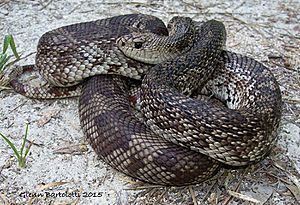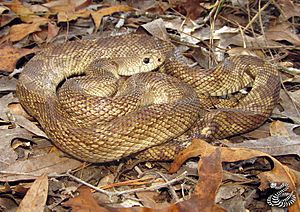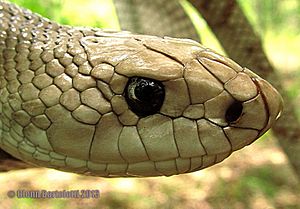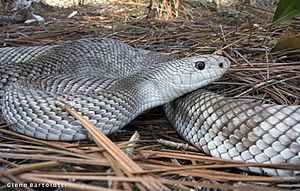Eastern pine snake facts for kids
Quick facts for kids Eastern pine snake |
|
|---|---|
 |
|
| Suwanee County, FL - pine snake | |
| Conservation status | |
| Scientific classification | |
| Genus: |
Pituophis
|
| Species: |
melanoleucus
|
| Synonyms | |
|
|
The pine snake (scientific name: Pituophis melanoleucus) is a type of snake found in the southeastern United States. It is not venomous, meaning it's not poisonous. This snake belongs to a large group of snakes called Colubridae. There are three main types, or subspecies, of pine snakes.
Contents
Meet the Pine Snake Family
There are three recognized types of pine snakes. They are all part of the Pituophis melanoleucus species.
- The northern pine snake (P. m. melanoleucus)
- The black pine snake (P. m. lodingi)
- The Florida pine snake (P. m. mugitus)
The name lodingi honors Peder Henry Löding. He was a Danish-born snake expert who lived in Alabama.
Pine snakes have many common names. People might call them a pinesnake, bullsnake, or even a chicken snake. Other names include carpet snake, eastern pine snake, or white gopher snake.
What Does a Pine Snake Look Like?
Adult pine snakes are quite large. They can grow to be about 48 to 90 inches (120 to 230 cm) long. They have a strong, muscular body. Their head is small and a bit pointed. They have a special scale on their nose that points upwards.
Their bodies are covered in scales that have a ridge, like a keel on a boat. The color of pine snakes can vary. They usually have a light background color. Over this, they have blotches of black, brown, or reddish-brown.
Where Do Pine Snakes Live?
The pine snake lives in many parts of the United States. You can find them in states like Alabama, Florida, Georgia, and New Jersey. They also live in North and South Carolina, Tennessee, and Virginia.
These snakes like to live in places with sandy soil. This includes pine forests, sandy pine-oak woodlands, and open fields. They need well-drained, sandy spots to lay their eggs and to hide during cold weather. They can live from sea level up to very high elevations.
A small group of pine snakes has even started living in the Netherlands. These snakes likely came from pets that were released or escaped.
How Pine Snakes Live and Hunt
Pine snakes are hunters. They mostly eat rats, mice, moles, and other small mammals. They also eat eggs. These snakes often go into rodent burrows to find their food. When they find prey, they might press the animals against the burrow walls to catch them.
Pine snakes spend time underground. They do this when it's very cold or very hot outside. This helps them stay safe and comfortable.
When a pine snake feels threatened, it makes a loud hissing sound. It might also flatten its head and shake its tail. This can make a rattling sound, similar to a rattlesnake. They make this sound by forcing air out of their lungs.
Pine Snake Babies
Pine snakes mate in the spring. The female snake then lays her eggs in June or August. A female can lay anywhere from 3 to 24 eggs at one time.
The eggs are laid in sandy burrows or under large rocks or logs. The eggs are quite big, about 2.6 inches (6.6 cm) long. They hatch after about 64 to 79 days. When they hatch, the baby snakes are already about 13 to 18 inches (33 to 45 cm) long.
Are Pine Snakes in Danger?
The pine snake is listed as a "least concern" species by the IUCN Red List. This means they are not currently in serious danger of disappearing. They live in many different places, and there are many of them.
However, the number of pine snakes seems to be slowly going down. This is mainly because their homes are being destroyed or changed by humans. Luckily, pine snakes live in many protected areas, which helps keep them safe.







